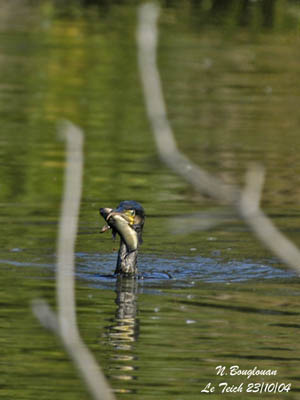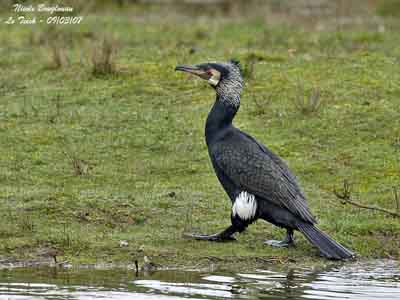
Great Cormorant
Phalacrocorax carbo
Suliformes Order – Phalacrocoracidae Family
BIOMETRICS:
Length : 80-100 cm
Wingspan : 130-160 cm
Weight : 1800-2800 g
LONGEVITY: Up to 23 years
DESCRIPTION:
Great Cormorant is a beautiful bird, widespread throughout the world. Its fishing ability may be as turned to man’s advantage in the Far East, or considered as fish competitor in several other countries and persecuted.

Adult in breeding plumage has glossy black plumage overall, with bronze reflections on lower back, rump and wings, and rather blue in upper back and tail. Plumage shows scaled effect.
Underparts are black. We can see a conspicuous white patch on the thighs.
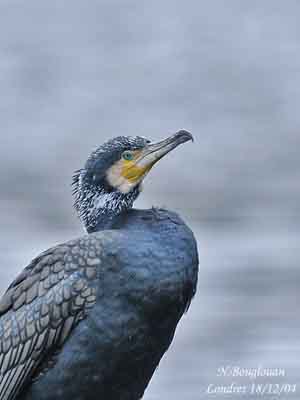
On the head, the chin is black, but cheeks and throat are covered with bare white skin. Head is black with more or less white feathers on the loosely crested nape which is formed by elongated feathers. According to each bird, we can see white short feathers extending broadly on the rear neck and ending in narrower collar on the foreneck.
The thin, straight bill is horn-coloured, with yellow to orange-red gape and hooked tip. The eyes are emerald. The short legs and the webbed feet are black.
Outside breeding season, Great Cormorant looses most of its white feathers and has duller plumage.
Both sexes are similar. Male is slightly larger than female, with larger bill.
Juvenile has brownish neck and white belly, and sometimes mottled pale brown breast, neck and flanks.
Second year resembles adult, but browner.
Young reaches its sexual maturity at 3-5 years.

Several sub-species display more or less white in plumage:
Phalacrocorax carbo carbo nesting on Atlantic coasts.
Phalacrocorax carbo sinensis breeding from southern Europe to Central Asia, with extensive white on throat and neck.
Phalacrocorax carbo hanedae, from Japan.
Phalacrocorax carbo maroccanus, breeds in Morocco. It has white throat and foreneck.
Phalacrocorax carbo lucidus from tropical Africa, with white cheeks, throat and neck, and sometimes breast and belly too.
Phalacrocorax carbo novaehollandiae, from Australia, Tanzania and New Zealand, with a crest.
VOICE: Great Cormorant utters guttural croaking at nest and roost.
It is rather silent when away from the colony.
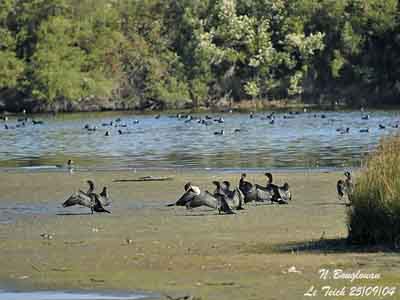
HABITAT:
Great Cormorant frequents open marine and inland waters. It is found on rocky or sandy sheltered coasts and estuaries.
It is rarely seen far from the coast. The species P.c. sinensis prefers inland waters and frequents lakes, reservoirs and rivers.
Great Cormorant breeds on cliffs, among boulders, man-made structures and inshore islands. The birds which nest inland breed on trees, bushes, in reedbeds and even on the bare ground.
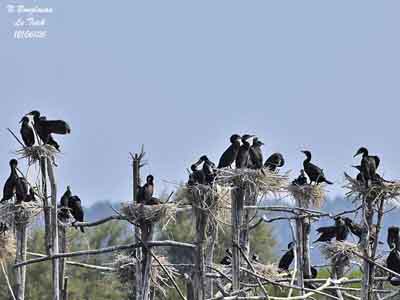
RANGE:
Great Cormorant is found in northern Atlantic, Africa, Eurasia and Australasia. Birds move according to food resources.
BEHAVIOUR:
Great Cormorant feeds primarily on fish, but it also takes crustaceans and amphibians. It usually feeds in shallow water. When the prey is caught with the bill, the bird brings it to the surface, in order to shake it and then, it tosses it before swallowing in the right way.
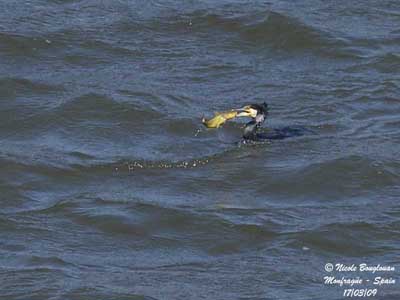
It swims under water in order to pursue its prey, only using its webbed feet. Outside breeding season, birds may fish in small groups, but they are often seen alone.
Great Cormorants spend most of their time sitting upright in rows on a sandy bank, or trees and man-made structures.
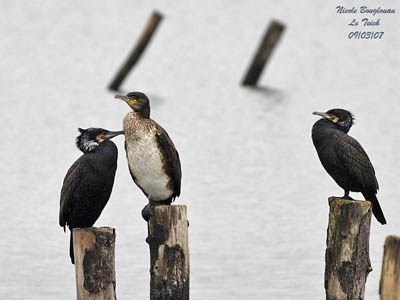
Great Cormorants are often considered as competitors by fishermen, and they have been persecuted. But their fishing abilities are sometimes turned to man’s advantage, helping humans to fish, catching the prey without swallowing. Men put them a neck collar to prevent it, and send them to fish from a boat.
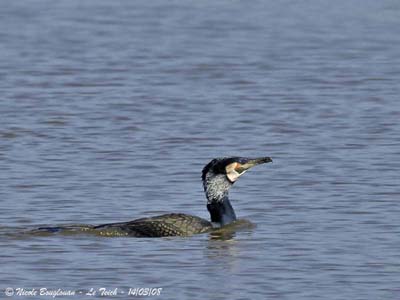
Great Cormorants have special feathers witch allow air to escape and water to penetrate the plumage. Under water, swimming is more efficient. But it means that the bird has to dry its plumage in a characteristic posture, with wings spread out, perched on a branch. This pose may also help to digestion. It consumes about 400 to 700 grams of fish per day.
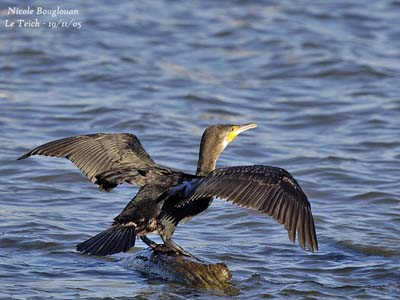
During courtship displays, the white thigh patches are often exposed, when the male rests on the water, thanks to frequent wing beats while the bird projects the head back and fans its tail.
Other display shows the male swinging its head back and forth, with erect tail, while it is calling loudly. Female responds by swinging slightly its head and “purring”.
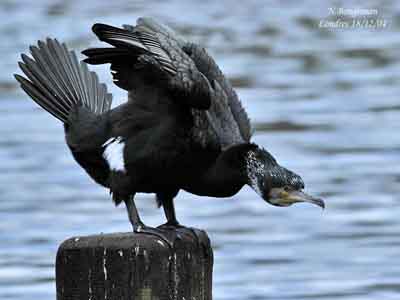
It is very gregarious and often seen in flocks when feeding and nesting.
Great Cormorant has been observed swallowing small pebbles when it needs extra weight to dive more easily. It regurgitates them after feeding.
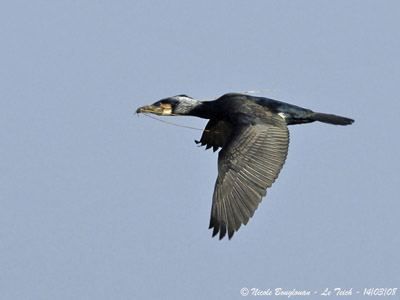
FLIGHT:
Great Cormorant performs fast flight, alternating steady wing beats and glides. It circles inland waters before landing in shallow glide. Its take-off is laboured, with some bounds on the surface before the flight. When they fly in flock, they form a loose “V”.
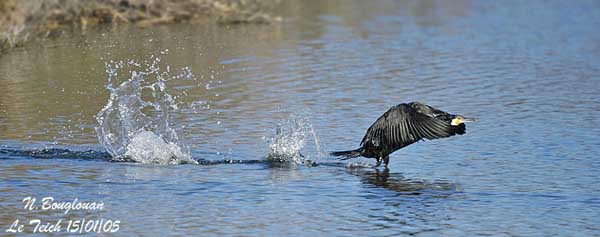
REPRODUCTION:
Great Cormorant breeds at any time, according to food resources.
It breeds in colonies which may gather up to 2000 pairs, although smaller colonies are typical. The colony is often close to other species such as darters, herons, spoonbills…
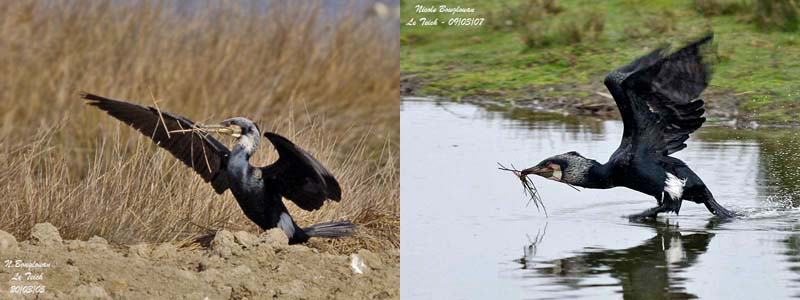
Parents build the nest with sticks, reeds and seaweeds. The interior is lined with soft materials. It is situated in cliffs, trees, bushes, according to the region. It is often reused.
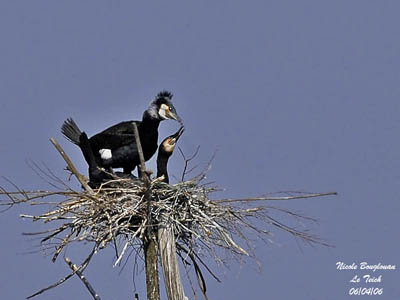
Female lays 2 to 6 eggs, usually 3-4 in average. Both parents incubate during 27 to 31 days. They use their large webbed feet to incubate the eggs. They place the eggs above the feet, to warm them between feet and body.
Chicks hatch at intervals and are altricial. They are blind and naked at hatching, but they are covered with black down very quickly.
Both adults feed the young with a regurgitated liquid during the first days. Later, parents bring solid food at nest, but the chicks take it directly into their throats.
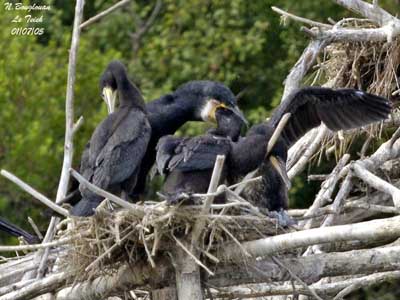
Young fledge about 50 days after hatching, but they remain with their parents for about 50 days more, depending on them for food.
This species produces only one brood per year.
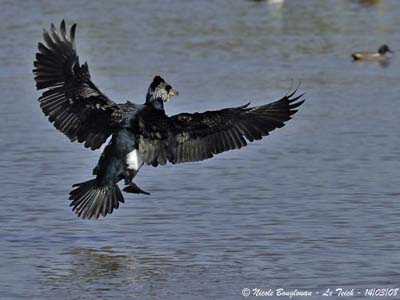
DIET :
Great Cormorant feeds mainly on numerous kinds of fishes, but when fishing in freshwater, it also consumes crustaceans, amphibians and insects.
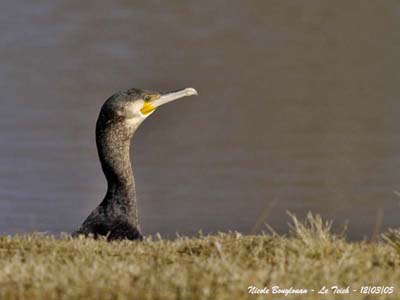
PROTECTION / THREATS / STATUS :
Considered as important fish competitor, the Great Cormorant was almost extinct in Europe in the past. However, increases have been observed in recent years, thanks to intensive protections.
But is some countries, increasing conflicts with fisheries and fish farms still involve new persecution.
In addition, hatchlings may be preyed upon by raptors before fledging.
Fortunately, populations are important, and the numbers are stabilized for the moment.
Fr: Grand Cormoran
All : Kormoran
Esp : Cormorán grande
Ital : Marangone
Nd : Aalscholver
Russe : Большой баклан
Sd: Storskarv
Photographs and text by Nicole Bouglouan
Sources :
HANDBOOK OF THE BIRDS OF THE WORLD vol 1 by Josep del Hoyo-Andrew Elliot-Jordi Sargatal - Lynx Edicions - ISBN: 8487334105
THE HANDBOOK OF BIRD IDENTIFICATION FOR EUROPE AND THE WESTERN PALEARCTIC by Mark Beaman, Steve Madge - C.Helm - ISBN: 0713639601
THE COMPLETE BOOK OF BRITISH BIRDS – Written by “Royal Society for the Protection of Birds” experts - Préface de Magnus Magnusson - Michael Cady- Rob Hume Editors - ISBN: 0749509112
